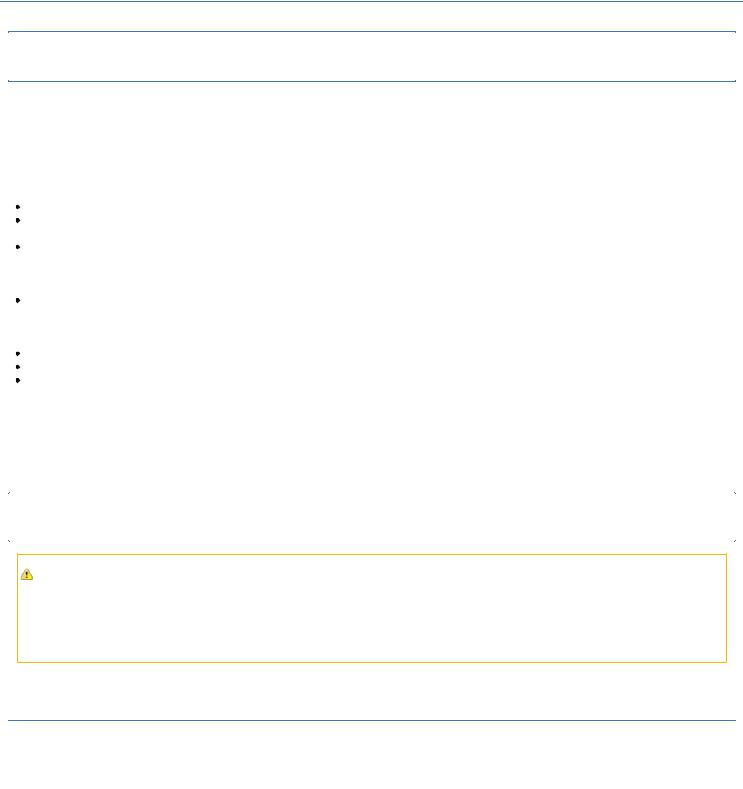
JPL_Coding_Standard_Java
.pdf
Java Coding Standard - Confluence |
1/25/10 1:40 PM |
references (CERT), OBJ02-J: Avoid using finalizers. references (Effective 2008), Item 7 (Avoid finalizers).
references (Puzzlers 2005), Rule 7.5 (Finalizers are unpredictable, dangerous and slow).
R14. do not implement the Cloneable interface
The clone() method should never be overridden or even called.
Rationale
As stated in (Effective 2008): "If implementing the Cloneable interface is to have any effect on a class, the class and all of its superclasses must obey a fairly complex, unenforceable, and thinly documented protocol" ... "it's safe to say that other interfaces should not extend it, and that classes designed for inheritance should not implement it. Because of the many shortcomings, some expert programmers simply choose never to override the clone method and never to invoke it except, perhaps, to copy arrays".
Examples
The following example shows a Sheep class, and the sub class Dolly which defines two alternative ways of creating copies of a Dolly object, one using a copy constructor and one using a copy factory. Normally only one of these alternatives would be provided.
class Sheep {
...
}
class Dolly extends Sheep {
//normal constructor: public Dolly() {
...
}
//copy constructor:
public Dolly(Dolly dolly) {
...
} |
|
|
|
|
|
|
|
|
|
// copy factory: |
|
|
|
|
|
|
|||
public static Dolly newInstance(Dolly dolly) { |
|
|
|
||||||
... |
|
|
|
|
|
|
|
|
|
} |
|
|
|
|
|
|
|
|
|
} |
|
|
|
|
|
|
|
|
|
class Cloning |
{ |
|
|
|
|
|
|
|
|
Dolly |
dolly |
= |
new |
Dolly(); |
// |
create initial |
object |
||
Dolly |
dolly1 |
= |
new |
Dolly(dolly); |
// |
copy |
using |
copy |
constructor |
Dolly |
dolly2 |
= |
Dolly.newInstance(dolly); |
// |
copy |
using |
copy |
factory |
|
} |
|
|
|
|
|
|
|
|
|
The Dolly(Dolly dolly) constructor creates a new Dolly object based on its argument, copying what needs to be copied. Likewise, the alternative static factory method newInstance(Dolly dolly) serves the same purpose.
Literature
references (Effective 2008), Item 11 (Override clone judiciously).
references (Puzzlers 2005), Rule 7.6 (Cloned objects can share internal state).
R15. do not call nonfinal methods in constructors
A nonfinal method should not be called from within a constructor.
Elaboration
A method is final if either it is declared within a final class (declared with a final modifier), or if the method is declared final with the final modifier, or if it is declared private. In these cases the method cannot be overridden by a subclass.
Rationale
If such a non-final, non-private method is called in the constructor of the superclass, the call will get dispatched to the sub class, which has not yet been initialized because classes are initialized top down from superclass to sub class, resulting in unpredictable behavior due to access to uninitialized state.
https://jplwiki.jpl.nasa.gov:8443/pages/viewpage.action?spaceKey=javastd&title=Java+Coding+Standard&decorator=printable |
Page 11 of 40 |

Java Coding Standard - Confluence |
1/25/10 1:40 PM |
Examples
The following example illustrates the problem:
abstract |
class |
Car { |
|
|
private |
int speed; |
|
||
public |
Car() |
{ |
|
|
speed |
= |
computeSpeed(); // |
not ok |
|
} |
|
|
|
|
abstract int computeSpeed(); // nonfinal |
||||
... |
|
|
|
|
} |
|
|
|
|
class Golf extends Car { |
|
|||
private |
boolean gti; |
|
||
public Golf(boolean gti) { |
|
|||
this.gti = gti; |
|
|||
} |
|
|
|
|
@Override |
int |
computeSpeed() |
{ |
|
return |
(gti |
? 180 : 150); |
// called before constructor |
|
} |
|
|
|
|
... |
|
|
|
|
} |
|
|
|
|
|
|
|
|
|
The Car constructor calls the nonfinal (abstract) method computeSpeed. This call is dispatched to the Golf subclass, where the overriding method refers to the gti field. However, this has the default initial value false since it has not yet been initialized by the Golf constructor. The result is that the speed value will always get the value 150.
Literature
references (Effective 2008), Item 17 (Design and document inheritance or else prohibit it).
references (Puzzlers 2005), Rule 7.2 (Invoking an overridden method from a constructor causes method to run before instance is initialized). references (Elements 2001), Rule 81 (Do not call nonfinal methods from within a constructor).
references (FindBugs), Rule UR_UNINIT_READ_CALLED_FROM_SUPER_CONSTRUCTOR.
R16. select composition over inheritance
Composition should be used in favor of inheritance unless inheritance is the most natural solution. That is, inheritance should not be used as the default way to compose classes.
Elaboration
The terms inheritance and composition are defined as follows. Consider a class B being built using a class A as a building block. Using inheritance the definition of B might appear as follows (in principle):
// inheritance:
class B extends A {
...
}
Using composition on the other hand, the definition of B might appear as follows (in principle):
// composition:
class B {
A a = new A(...);
...
}
In the latter case all features from A that need to be available in B have to be redefined in B and delegated to A. This will guarantee that A stays encapsulated.
Classes that are meant to be extended should document for each overridable method how it is used in other methods of the class (see example below for an explanation why).
https://jplwiki.jpl.nasa.gov:8443/pages/viewpage.action?spaceKey=javastd&title=Java+Coding+Standard&decorator=printable Page 12 of 40

Java Coding Standard - Confluence |
1/25/10 1:40 PM |
Rationale
Composition allows the used class to be treated as a black box whereas inheritance allows the developer to modify the behavior of the superclass. Extension through composition makes classes more robust to changes in the parent. Extension through inheritance make sharing protected state possible.
Examples
The following example illustrates a situation where method overriding has unexpected effects. The class InstrumentedHashSet is an extension of the HashSet class with a counter, which counts how many elements have been added to the hash set. The sub class overrides the add method and the addAll method. The problem arises when calling addAll(c). This method will increase the counter according to how many elements c contains, and then call super.addAll(c), which again calls add(e) for each element in c. Each such call will, however, be a call to the add method in the sub class, which will count again. Hence the counter will be incremented with 2 times the number of elements in c.
public class InstrumentedHashSet<E> extends HashSet<E> { private int addCount = 0;
@Override public boolean add(E e) { addCount++;
return super.add(e);
}
@Override public boolean addAll(Collection<? extends E> c) { addCount += c.size();
return super.addAll(c);
}
public int getAddCount() { return addCount;
}
}
The alternative would be to use composition where an instance of the HashSet class is created as a field inside the InstrumentedHashSet class. In this case all methods that should be visible in the InstrumentedHashSet class must of course be defined explicitly, yielding an extra burden, but perhaps a price worth paying for a safer class.
public class InstrumentedHashSet<E> {
private HashSet<E> hashSet = new HashSet<E>(); private int addCount = 0;
public boolean add(E e) { addCount++;
return hashSet.add(e);
}
public boolean addAll(Collection<? extends E> c) { addCount += c.size();
return hashSet.addAll(c);
}
boolean contains(Object o) { return hashSet.contains(o);
}
public int getAddCount() { return addCount;
}
}
Literature
references (CERT), OBJ01-J: Understand how a superclass can affect a subclass.
references (CERT), CON00-J: Do not invoke a superclass method or constructor from a synchronized region in the subclass. references (CERT), CON04-J: Do not call overridable methods from synchronized regions.
references (Effective 2008), Item 16 (Favor composition over inheritance), and Item 17 (Design and document for inheritance or else prohibit it).
fields
R17. make fields private
Fields in a class should be made private with accessor member methods granting access to them to external entities.
https://jplwiki.jpl.nasa.gov:8443/pages/viewpage.action?spaceKey=javastd&title=Java+Coding+Standard&decorator=printable |
Page 13 of 40 |

Java Coding Standard - Confluence |
1/25/10 1:40 PM |
Elaboration
The same advice applies to static fields, with the exception that one can expose constants via static final fields. However, such exposed constants should denote primitive values or references to immutable objects.
Rationale
The better encapsulated a software package is, the easier it is to learn to use it and the easier it is to maintain it. With good encapsulation implementations can be changed more easily. In particular, making fields public has several drawbacks. First, it gives up control over the internal class structure, making it difficult later to change this structure. Second, by making a field directly accessible from outside the class, it becomes impossible from within the class to control what values are stored in the field. This makes it impossible locally within the class to enforce an invariant on the field. Third, by making a field directly accessible from outside the class, it becomes difficult to program additional actions to be carried out when the field is accessed (without using some form of program transformation, for example using aspect oriented programming). Fourth, and finally, by only providing access to a field through accessor methods, it becomes easier to vary synchronization policies.
Examples
// ok since no fields except constant are made public:
public class Rover {
public static final String DEVELOPER = "JPL";
private String name; private Position position;
String getName() { return name;
}
Position getPosition() { return position;
}
void setPosition(Position position) { this.position = position;
}
}
Literature
references (AmbySoft), Section 2.2 Member Function Visibility. references (AmbySoft), Section 3.2 Field Visibility.
references (AmbySoft), Section 3.4 The Use of Accessor Member Functions. references (AmbySoft), Section 6.1.5 Minimize the Public and Protected Interface. references (CERT), SEC05-J: Minimize accessibility of classes and their members. references (CERT), SCP00-J: Use as minimal scope as possible for all variables. references (CERT), OBJ00-J: Declare data members private.
references (GeoSoft), Rule 44 and Rule 48. references (GeoSoft), Rule 46.
references (Lea), Recommendations, Item 8 and Item 14 and Item 15. references (Macadamiam), Naming Conventions, Function Names, last paragraph.
references (SUN-code), page 16, Section 10.1 (Providing Access to Instance and Class Variables). references (JPL-C-STD), Rule 13 (limited scope).
references (Effective 2008), Item 6 (Eliminate obsolete object references) and Item 45 (Minimize the scope of local variables).
references (Effective 2008), Item 13 (Minimize the accessibility of classes and members), and Item 14 (In public classes, use accessor methods, not public fields).
references (Elements 2001), Rule 71 (Make all fields private).
references (FindBugs), Rules MS_FINAL_PKGPROTECT, MS_MUTABLE_ARRAY, MS_MUTABLE_HASHTABLE, MS_OOI_PKGPROTECT, and MS_PKGPROTECT. references (PMD), Rule SingularField.
R18. do not use static mutable fields
There should be no static mutable fields. A static field is mutable if it is not declared final, or if it is declared final but points to a mutable object.
Rationale
Static mutable fields act like globals in non-OO languages. They make methods more context-dependent, hide possible side effects, sometimes present synchronized access problems.
Exceptions to the rule
https://jplwiki.jpl.nasa.gov:8443/pages/viewpage.action?spaceKey=javastd&title=Java+Coding+Standard&decorator=printable |
Page 14 of 40 |

Java Coding Standard - Confluence |
1/25/10 1:40 PM |
An exception is a singleton, where a class is instantiated to a single object, which is needed to coordinate actions across the system. In this case it would become cumbersome to pass this object around as parameter to constructors of classes referring to the object.
Another exception is a counter used to keep track of the use of a class, for example counting how many objects are created of the class.
Literature
references (Lea), Recommendations, Item 10.
references (CERT), OBJ31-J: Do not use public static non-final variables. references (FindBugs), Rule MS_CANNOT_BE_FINAL.
R19. declare immutable fields final
The final keyword should be used to declare fields that never have their values changed after construction and are intended to be constant.
Elaboration
If a constant is not declared static, every instance of the class in which it is defined will retain its own copy of the constant. Hence, if the constant is the same across objects, it should be declared static final. If the field forms part of a set of related, and alternative, constants, an enumeration type should be used.
Rationale
Using the keyword final improves robustness and maintainability because the compiler, static analysis tools, and thread analysis tools can help enforce the explicitly enforced concept.
Exceptions to the rule
The typical exceptions are containers. Consider for example a vector field. This field will stay constant whereas of course its contents will change. See example. It would cause notational clutteredness to declare such containers final and would furthermore potentially cause a reader to wrongly believe that the container itself cannot change, which it can! That is, the final modifier only refers to the reference to the object, not the contents of the object, which still can be mutable.
Examples
public class Constants |
{ |
|
|
|
static final |
double |
PI |
= 3.14159265; |
// ok |
final double |
thisPI |
= |
3.14159265; |
// ok, but could also be static |
double maybePI = 3.14159265; |
// not ok, should be final and preferably also static |
|||
List<Double> |
doubles1 = new Vector<Double>(); |
// ok, although doubles1 reference does not change value |
||
final List<Double> doubles2 = new Vector<Double>(); // ok, but not necessary, contents is mutable anyway |
||||
void tryit() |
{ |
|
|
|
doubles1.add(PI); |
// |
reference itself does not change, contents does |
||
doubles2.add(PI); |
// |
reference itself does not |
change, contents does |
|
} |
|
|
|
|
} |
|
|
|
|
|
|
|
|
|
Literature
references (Lea), Recommendations, Item 12.
references (CERT), DCL31-J: Qualify mathematical constants with the static and final modifiers. references (CERT), OBJ03-J: Be aware that a final reference may not always refer to immutable data. references (JPL-C-STD), Rule 13 (limited scope).
references (PMD), Rule ImmutableField.
R20. initialize fields before use
Fields should be explicitly initialized before used. Specifically, it should be ensured that static fields have sensible values even if no instances are ever created. Use static initializers (static) if necessary. All fields should be initialized in constructors (or object factories if used instead of constructors).
Rationale
This discipline helps preventing null pointer exceptions.
Literature
https://jplwiki.jpl.nasa.gov:8443/pages/viewpage.action?spaceKey=javastd&title=Java+Coding+Standard&decorator=printable |
Page 15 of 40 |

Java Coding Standard - Confluence |
1/25/10 1:40 PM |
references (AmbySoft), Section 3.5 Always Initialize Static Fields. references (Lea), Recommendations, Item 9.
references (Lea), Recommendations, Item 18.
references (FindBugs), Rules NP_UNWRITTEN_FIELD, UWF_UNWRITTEN_FIELD, and UWF_FIELD_NOT_INITIALIZED_IN_CONSTRUCTOR. references (PMD), Rule DataflowAnomalyAnalysis.
methods
R21. use assertions
Use assertions to check method boundary conditions.
Elaboration
Every class may supply a method, say 'boolean invariant()', to perform a sanity check on the class that will verify if the class invariant holds.
Each non-trivial method in a class should have the following assertions.
Pre-condition - before performing its actions:
parameter check: the method should verify that all the parameters passed to the method are valid.
method specific class check: the method should verify that the class is in a proper state for this method to be called. For example, you can't pop an element from an empty stack.
class invariant check: the method may call the invariant method to verify that the class invariant still holds.
Intermediate assertions - throughout method body:
assertions should be used to perform basic sanity checks throughout the code, for example expressing loop invariants.
Post-condition - after performing its actions the following check should be performed:
return value check: the method may verify that the value it returns is correct.
method specific class check: the method may verify that the state of the class changed correctly.
class invariant check: the method may call the invariant method to verify that the class invariant still holds.
Note that pre-condition checks can be interpreted more liberally to include checks on any form of input. This would include program parameters and information read from files. However, external input should be validated with if-statements (see below), not via assertions.
The expressions occurring in assertions should be side effect free.
Java provides an assertion feature, using one of two forms:
assert Expression;
assert Expression1 : Expression2;
Be Careful
In order for such assertions to be enabled the code has to be compiled with option -ea (enable assertions). This has the advantage that assertions can be disabled in case they are computationally expensive. The fact that assertions are not activated by default, however, has the disadvantage that unless care is taken, the assertions may not be checked.
Assertions cause exceptions to be thrown, and unless caught such assertions cause program termination. One can also define a home grown set of assertion methods, for example as follows:
class Assert {
public static final boolean CONTRACT = true;
public static void preCondition(boolean b) { if (CONTRACT && !b) {
// some reaction
https://jplwiki.jpl.nasa.gov:8443/pages/viewpage.action?spaceKey=javastd&title=Java+Coding+Standard&decorator=printable |
Page 16 of 40 |

Java Coding Standard - Confluence |
1/25/10 1:40 PM |
}
}
public static void postCondition(boolean b) { if (CONTRACT &&!b) {
// some reaction
}
}
}
They can then be called, for example conditionally on the value of the CONTRACT constant:
// import all static Contract fields and methods: import static contract.Contract.*;
class MyMathClass { double sqrt(double x) {
if (CONTRACT) preCondition(x >= 0); double result;
...
result = ...;
if (CONTRACT) postCondition(result >= 0 && Math.abs((result * result) - x) <= EPSILON); return result;
}
}
The Java compiler will perform dead code elimination, and in case CONTRACT is false, the above contract preand post-condition calls will be eliminated by the compiler.
A sub class method that overrides a superclass method should preserve the preand post conditions of the superclass method. This can be done by making the superclass method final and let it call a protected nonfinal method, which is then overridden by the sub class. The final superclass method will then check the preand post conditions.
Rationale
Checking pre-conditions, and reacting locally to violations, make functions able to handle any context in which they are applied. Checking post-conditions and intermediate assertions help ensure functional correctness of the methods. Liberal use of assertions increase the chance of detecting bugs during testing.
Literature
references (CERT), EXP31-J: Avoid side effects in assertions. references (CERT), SDV00-J: Always validate user input.
references (CERT), SDV15-J: Library methods should validate their parameters.
references (Macmadiam), Testing/Debug Support, Class Invariant and Assertions and Defensive Programming references (JPL-C-STD), Rule 15 (checking parameter values).
references (JPL-C-STD), Rule 16 (use of assertions).
references (Effective 2008) Item 38 (Check parameters for validity).
references (Elements 2001), Rule 89 (Program by contracts), Rule 90 (Use dead code elimination to implement assertions), Rule 91 (Use assertions to catch logic errors in your code), and Rule 92 (Use assertions to test preand postconditions of a method).
references (FindBugs), Rule NP_ARGUMENT_MIGHT_BE_NULL.
R22. use annotations
Annotations should be used to indicate intentions that can then be checked by the compiler or by static analyzers.
Elaboration
Specifically, a method that overrides a method in a superclass should be defined with an @Override annotation to indicate the intent.
Method return types and method/constructor argument types can in addition be annotated with @Null to indicate the possibility of a null value to be returned, respectively passed as an argument. The @Null annotation has to be user-defined as follows:
@interface Null{}
The @Null annotation, however, is somewhat controversial since it is not a standard annotation supported by the Java compiler. FindBugs (FindBugs) has an annotation for non-nullness, hence the opposite, and checks accordingly. It might be better to conform with FindBugs. However, recent research (SpeC# http://research.microsoft.com/en-us/projects/specsharp at Microsoft Research) suggests that assuming null free types as a default is the most effective approach, an approach that has now also been adopted for the Eiffel programming language (http://www.eiffel.com
at Microsoft Research) suggests that assuming null free types as a default is the most effective approach, an approach that has now also been adopted for the Eiffel programming language (http://www.eiffel.com ).
).
https://jplwiki.jpl.nasa.gov:8443/pages/viewpage.action?spaceKey=javastd&title=Java+Coding+Standard&decorator=printable |
Page 17 of 40 |

Java Coding Standard - Confluence |
1/25/10 1:40 PM |
Rationale
Making explicit the intent to override a parent method leads to early detection of typos. When overriding a method in a superclass it is very easy to either misspell the method name or indicate wrong argument types. In such a case the method in the superclass will mistakenly not be overridden, but instead a new method will be defined in the sub class. The Java compiler may not detect this.
@Null annotations make explicit what input/output values can be null. It allows the developer to devote the time and effort to defensively protect against generating a NullPointerException for those items that can be null. It also allows static analyzers to provide early warning of violations to prevent difficult to find and understand runtime errors.
Examples
The following code illustrates the use of @Override annotations:
// ok:
@Override public int hashCode() {
return location.getX() + location.getY();
}
//ok, except for the miss-spelling of hashcode,
//but this can now be caught by the compiler:
@Override public int hashcode() { // should be hashCode return location.getX() + location.getY();
}
//not ok, @0verride is missing, and
//miss-spelling of hashcode will not be caught:
public int hashcode() {
return location.getX() + location.getY();
}
The following code illustrates the use of @Null annotations:
// ok |
: annotations |
used to indicate potential for null values |
|
@interface Null{} |
|
||
class |
NullAnnotation |
{ |
|
public @Null Result computeResult(@Null Data data) { |
|||
if (data |
== null) { |
||
|
return |
null; |
|
}else {
return new Result(data);
}
}
}
Literature
referecnes (Effective 2008), Item 36 (Consistently use the Override annotation). references (Puzzlers 2005), Rule 9.1 (It is easy to overload when you intend to override).
references (FindBugs), Rules NP_BOOLEAN_RETURN_NULL, NP_TOSTRING_COULD_RETURN_NULL, and NP_NONNULL_RETURN_VIOLATION. references (PMD), Rules FinalizeOverloaded, SuspiciousHashcodeMethodName and SuspiciousEqualsMethodName.
R23. restrict method overloading
Method overloading on argument types should be restricted to cases where the argument types are radically different.
Elaboration
Two types are radically different if it is impossible to cast or auto-box/auto-unbox a value of one type to the other. Overloading on arity is unproblematic, as in having a one-argument version versus a two-argument version. Note that a variable argument method can be considered as an infinite set of overloaded methods, each with a finite number of arguments, and each of which should satisfy the above rule about radically different arguments with respect to other methods with the same number of arguments.
Rationale
Java method resolution is static, based on the listed types, not the actual types of arguments. Consequently, the results can be counterintuitive.
https://jplwiki.jpl.nasa.gov:8443/pages/viewpage.action?spaceKey=javastd&title=Java+Coding+Standard&decorator=printable |
Page 18 of 40 |

Java Coding Standard - Confluence |
1/25/10 1:40 PM |
Examples
As an example, the following program violates this rule. It outputs "object", contrary to what one might think.
class |
Classifier { |
|
|
|
|
String |
identify(Object |
x) |
{ return "object"; } |
|
|
String |
identify(Integer |
x) |
{ return "integer"; } // overloading violates |
rule |
|
} |
|
|
|
|
|
class |
Relay { |
|
|
|
|
String relay(Object obj) { |
return (new Classifier()).identify(obj); } // |
here we loose the fact that obj is an Integer |
|||
} |
|
|
|
|
|
public |
class Overloading |
{ |
|
|
|
public static void main(String[] args) { Relay relayer = new Relay();
Integer i = new Integer(17); // it is indeed an Integer System.out.println(relayer.relay(i));
}
}
The problem arises because the identify method in class Classifier is overloaded with two types that are not radically different since instances of the Integer type can be cast into instances of the Object type (casting is not even required, forming a trivial case of casting).
Literature
references (CERT), DCL02-J: Do not overload variable argument methods. references (Lea), Recommendations, Item 21.
references (Effective 2008), Item 41 (Use overloading judiciously).
references (Puzzlers 2005), Rule 9.2 (Overload-resolution rules are not obvious).
R24. do not assign to parameters
One should not reassign values to parameters. Use local variables instead.
Rationale
Assignments to parameters will only have local effect, but may give the impression of having global effect. Avoid the confusion by not assigning to parameters. Parameters are meant to be inputs to the method and are not meant to function as local variables.
Literature
references (FindBugs), Rule IP_PARAMETER_IS_DEAD_BUT_OVERWRITTEN. references (PMD), Rule AvoidReassigningParameters.
R25. do not return null arrays or collections
One should not return the null value from a method that (type-wise) returns an array or a collection. Instead return an empty array or collection.
Rationale
Returning null puts an obligation on the caller of the method to check that the returned value is not null before any operations can be applied to it. Such checks are easily omitted causing difficult to find and understand runtime failures.
Comments
A stronger rule would be that a method should never return null. The current rule limits the restriction to only methods returning arrays or collections.
Literature
references (Effective 2008), Item 43 (Return empty arrays or collections, not null).
references (Puzzlers 2005), Rule 8.7 (Returning null instead of a zero-length array or collection is error prone). references (FindBugs), Rule PZLA_PREFER_ZERO_LENGTH_ARRAYS.
R26. do not call System.exit
https://jplwiki.jpl.nasa.gov:8443/pages/viewpage.action?spaceKey=javastd&title=Java+Coding+Standard&decorator=printable |
Page 19 of 40 |

Java Coding Standard - Confluence |
1/25/10 1:40 PM |
One should not call System.exit.
Rationale
Calling System.exit in a thread in a multi-threaded application can have as consequence that some other thread doing some important job will abruptly be killed. This may have as a result that the application may leave an externally persistent resource in a bad state.
Literature
references (FindBugs), Rule DM_EXIT.
declarations and statements
R27. have one concept per line
There should be no more than one statement or variable declaration per line.
Rationale
Very long declarations introducing several variables may be hard to read, especially if some of them have array brackets [] associated. Furthermore, multi declarations may lead to confusion if they contain initializations. Finally, it becomes impossible to comment each variable declaration. The rule has likely originated from C/C++ standards, where pointers can be incorrectly used, and where it perhaps the rule has a stronger motivation than in Java. The rule is, however, included here since having one declaration per line simply is easier to read.
Examples
// not ok - all declarations on one line: class MultipleDecls {
int i, j = 1, x[], y = 2, z;
...
}
//ok - declarations on individual lines:
class |
SingleDecls { |
||
int |
i; |
|
|
int |
j |
= |
1; |
int[] |
x; |
|
|
int |
y |
= |
2; |
int |
z; |
|
|
... |
|
|
|
} |
|
|
|
Note the declaration of x in the SingleDecls class: the array specifier [] is associated with the type int rather than with the identifier x. This is a recommended style, although not a rule in itself due to its low priority.
Literature
references (AmbySoft), Section 2.4.6 Write Short, Single Command Lines.
references (AmbySoft), Section 4.2 Declaring and Documenting Local Variables, Item 1. references (CERT), DCL04-J: Do not declare more than one variable per declaration. references (SUN-code), page 6, Section 6.1 (Number Per Line).
references (SUB-code), page 11, Section 7.1 (Simple Statements). references (JPL-C-STD), Rule 24.
R28. use braces in control structures
Braces should be used to group statements that are part of a control structure, such as an if-else or for statement.
Rationale
This makes it easier to add statements without accidentally introducing bugs due to forgetting to add braces. It also removes the risk of dangling else problems (determining what if-construct an else-construct belongs to).
Examples
https://jplwiki.jpl.nasa.gov:8443/pages/viewpage.action?spaceKey=javastd&title=Java+Coding+Standard&decorator=printable |
Page 20 of 40 |
